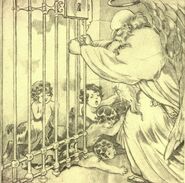This article could use a cleanup in order to be more legible and/or presentable. Please help improve this article in any way possible. Remember to follow our editing guidelines when improving existing articles. If you can improve this page, please edit it (Adding headers and subheaders, simplifying sentences, etc) or help by discussing possible changes.
If you need help with wiki markup, see the wiki markup page. If you want to try out wiki markup without damaging a page, why not use the sandbox?
In Greek mythology, Satyrs (in Roman mythology fauns) are a troop of male companions of Pan and Dionysus — "satyresses" were a late invention of poets — that roamed the woods and mountains.
The satyrs' chief was called Silenus, a minor deity associated (like Hermes and Priapus) with fertility and a follower of Dionysus These characters can be found in the only remaining satyr play Cyclops by Euripedes and the fragments of Sophocles' The Tracking Satyrs (Ichneutae). The satyr play was a lighthearted follow-up attached to the end of each trilogy of tragedies in Athenian festivals honoring Dionysus. These plays would take a lighthearted approach to the heavier subject matter of the tragedies in the series, featuring heroes speaking in tragic iambic verse and taking their situation seriously as to the flippant, irreverent and obscene remarks and antics of the satyrs.
The groundbreaking tragic playwright Aeschylus is said to have been especially loved for his satyr plays, but none of them has survived. Another horse-tailed satyr suspends his pipe-case from his erection, on an Attic black-figure plate, 520–500 BCE, from VulciAttic painted vases depict mature satyrs as being strongly built with flat noses, large pointed ears, long curly hair, and full beards, with wreaths of vine or ivy circling their balding heads. Satyrs often carry the thyrsus: the rod of Dionysus tipped with a pine cone.
Satyrs acquired their goat-like aspect through later Roman conflation with Faunus, a carefree Italic nature spirit of similar temperament. Hence satyrs are most commonly described in Latin literature as having the upper half of a man and the lower half of a goat, with a goat's tail in place of the Greek tradition of horse-tailed satyrs. Mature satyrs are often depicted in Roman art with goat's horns, while juveniles are often shown with bony nubs on their foreheads. Satyr on a mountain goat, drinking with women. Gandhara, 2nd-4th century.Satyrs are described as roguish but faint-hearted folk — subversive and dangerous, yet shy and cowardly. As Dionysiac creatures they are lovers of wine, women and boys, and are ready for every physical pleasure. They roam to the music of pipes (auloi), cymbals, castanets, and bagpipes, and love to dance with the nymphs (with whom they are obsessed, and whom they often pursue), and have a special form of dance called sikinnis. Because of their love of wine, they are often represented holding winecups, and appear often in the decorations on winecups.
Some satyrs are depicted as old. On painted vases and other Greek art, satyrs are represented in the three stages of a man's life: mature satyrs are bearded, and are shown as fat and balding, both a humiliating and unbecoming disfigurement in Greek culture.
Their habitats are the forests and mountains.
The word Satire, meaning human follies or mistakes, comes from the word Satyr. Satyrs were often depicted as fumbling, joking, and careless creatures.



